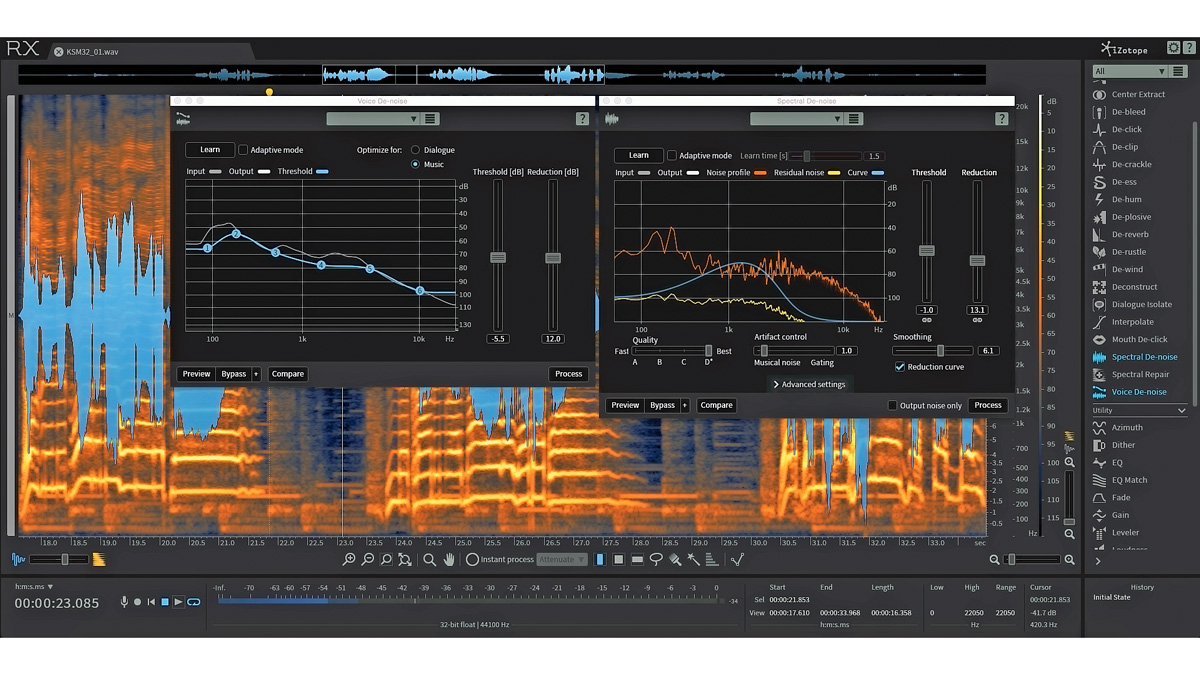MusicRadar Verdict
Again iZotope moves the RX platform forward to a place ahead of any competition. A truly powerful, innovative and intuitive toolset.
Pros
- +
Sheer quality and range of the repair modules.
- +
Easy to use interface with just the right amount of user definability.
- +
Connectivity with DAWs via plugin set and Connect/Monitor modules.
Cons
- -
Deciding which package to get.
- -
Not using your other noise reduction plugins again.
MusicRadar's got your back
The RX family of audio editing, restoration and repair tools moves into its sixth iteration.
The core audio editor has undergone no major changes, bar a slight facelift; with its adjustable waveform/spectrogram overlay display and Photoshop-esque selection tools there’s nothing to improve. Identifying problems in your audio and selecting the offending components is easy, though complex selections are possible (independent time/frequency, harmonic series, brush/lasso/magic wand); but that’s only the start of the journey.
On the right of the display is an expanded list of modules, split into Repair, Utility and Measurement groups. Our one negative about RX6 was that this list is now too large to be constantly visible, but then we found a Module List Filter for creating custom lists!
There are too many modules to cover in great depth here, so check the iZotope website for a full list of what is included in the three options (Elements, Standard & Advanced). RX6 has been developed to cater for music and post-production, with most of the Advanced-only modules aimed at the latter.
Elements will not disappoint and there are upgrade options should you want more
The module function and layout tweaks are useful and improve range and workflow across the board. Many of the new additions, such as Voice De-noise, Dialogue Isolate, Breath Control and Mouth De-click, are voice specific adaptations of existing modules and algorithms, which is obviously the key crossover between music and post production.
What helps make RX a flexible and creative toolset is that even the vocal-focused modules can be utilised for non-vocal usage, such as De-plosive to tame an over heavy kick drum. Workflow, alongside the excellent quality of the modules, is the primary focus of the platform.
With RX6 come significant tweaks and additions, the largest of which is Composite View (Standard and Advanced). This simple feature temporarily combines any number of related files, such as a drum multitrack, into a single editable waveform so common problems can be dealt with simultaneously, which saves time and reduces phase related problems.
Want all the hottest music and gear news, reviews, deals, features and more, direct to your inbox? Sign up here.
Features such as Connect (a link plugin that simplifies/expedites DAW/RX file sharing), Module Chain (user defined process chains), Find Similar and batch processing make RX6 uniquely flexible and efficient. For us Spectral De-noise and Spectral Repair remain the core components of RX, both of which have seen small improvements, and are available in Standard and Advanced packages, so choosing between these two will really depend on how much income you derive from audio work, and especially voice production, whether musical or in post-production.
Both are great value, though for the money the Standard package is a no-brainer. Elements provides a good value set of tools, with Voice De-noise and De-click/clip/hum modules capable of a large range of common repair jobs, though there is a big leap in capability with the Standard package thanks to the two core modules we have mentioned. But for the price, Elements will not disappoint and there are upgrade options should you want more.
